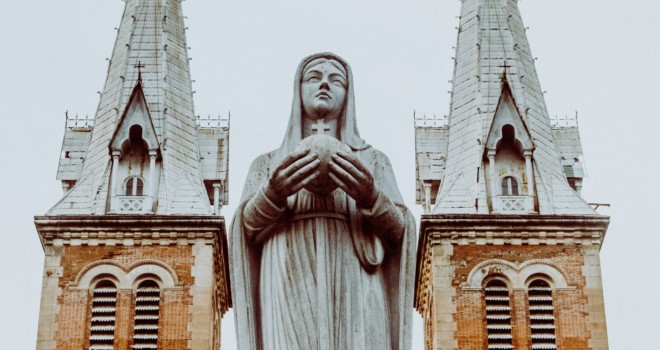The Church teaches that Mary is the way to Jesus,
but is this grounded in Scripture?
As Catholics we can point to the gospel stories of
the Annunciation, the wedding at Cana, and the cross and demonstrate through a
close, faithful readings of these texts that Mary is indeed the ‘way’ to the
Way.
But we can also look at her traditional title as the
‘Gate of Heaven’ which is biblically based. This title serves as further clear
confirmation of Mary’s significance.
Quite literally, Mary is the ‘gate’ through which
Christ enters the world. This title is one that is actually applied to her in
Scripture. Ezekiel 44:1-3 records that,
Then he brought me back to the outer gate of the sanctuary facing east, but it was closed.
The LORD said to me: This gate must remain closed; it must not be opened, and no one should come through it. Because the LORD, the God of Israel, came through it, it must remain closed. Only the prince may sit in it to eat a meal in the presence of the LORD; he must enter through the vestibule of the gate and leave the same way.
What was the holy gate through the Lord entered and
which must remain closed? Who else could it be but Mary Immaculate who remained
ever virgin after giving birth to Jesus? Church Fathers like St. Ambrose
and St. Augustine
and more contemporary authorities like St. Louis de Montfort and Blessed John Henry Newman all draw the obvious inference from this text.
It’s worth noting that similar prophetic language about gates and the entrance of a divine king can also be found in Psalm 24:7 and Isaiah 26:2.
The portal to heaven
A gate is quite simply a way of getting in or out of
somewhere. Usually they are two way. So if someone came out of a gate it’s a
safe bet that we can go where they came from using the same way.
In our collective imagination, gates can be portals
to other worlds. Ancient mythology is steeped in stories of other worlds
through which one must enter through a gate. Often the gate is as mysterious as
the other realm itself—and finding the gate is akin to discovering the world
beyond itself. In more modern times, the wardrobe of C.S. Lewis was a gate to
Narnia. In the Canadian-American television series Stargate the so-called
‘stargates’ were portals or shortcuts through space-time to other worlds.
Certainly these characteristics of gates apply to
Mary as Catholics understand and venerate her. St. Louis de Montfort describes her as the shortest way to get to Christ:
“the sure means and the straight and immaculate way” and again as “the most
easy, the most short, and the most perfect means by which to go to Jesus Christ.”
Likewise, Pope St. Pius X: “There is no surer or easier way than Mary in
uniting all men with Christ.”
The biblical background of city gates teaches us
even more about what it means that Mary is the Gate.
In the ancient world in general, walled cities, by
their very nature, meant that there were limited ways of getting in and out—the
gates. People familiar with sprawling cities like Chicago, Los Angeles, or
Houston may not be able to relate, but anyone who has been to Manhattan perhaps
can—there are only so many bridges, or tunnels, leading onto and off the
island. You are dependent on them for access.
But gates were more than just important passageways.
Gates: prophecy, justice, and mercy
The gates also served as places where important business
was done. They were seats of justice, marketplaces, public squares from which
prophets spoke, and vantage points from which the king appeared to the public,
according to the International
Bible Encyclopedia and Haaretz.
The legal-commercial function of gates is evident in
Genesis 23:17-18, where the gates of the city of Hebron are the context in
which Abraham makes a legal purchase of some land:
Thus Ephron’s field in Machpelah, facing Mamre, together with its cave and all the trees anywhere within its limits, was conveyed to Abraham by purchase in the presence of the Hittites, all who entered the gate of Ephron’s city.
The city gate as a place where the ideals of justice
and mercy are to be carried out comes to the fore in Amos 5:12 and 15:
Yes, I know how many are your crimes,
how grievous your sins:
Oppressing the just, accepting bribes,
turning away the needy at the gate.
Hate evil and love good,
and let justice prevail at the gate;
Then it may be that the LORD, the God of hosts,
will have pity on the remnant of Joseph.
The implications are immense for our understanding
of Mary. They reinforce the many titles and associated roles she has in our
lives, as a conduit of God’s mercy and lovingkindness, a place of refuge for
sinners, and a source of prophetic words.
A place for sorrow and triumph
In 2 Samuel, the gates play an intriguing role in
the drama of King David. First, in 2 Samuel 19:1, he takes to an area of the
gates seeking consolation amid his sorrow over the death of his son Absalom:
The king was shaken, and went up to the room over the city gate and wept. He said as he wept, “My son Absalom! My son, my son Absalom! If only I had died instead of you, Absalom, my son, my son!”
The gate also becomes a site for David to assert
himself. A few verses later, Joab tells him to make a public appearance or his
army will desert him. Eventually, in Verse 9, David relents,
So the king got up and sat at the gate. When all the people were told, “The king is sitting at the gate,” they came into his presence.
As Haaretz explains, this was the key moment in which David maintained control over the throne.
The city gates thus encompass a wide spectrum of
human experience, from sorrows to triumph.
Mary too embraces us in all our circumstances. To
her do we cry, ‘poor banished children of Eve,’ and through her we find mercy
and a vision of the blessed fruit of her womb, Jesus, as the old hymn says.
The beautiful gate
Finally, the gates were beautiful. In order to
fortify them some were solid stone, which, according to the International
Bible Encyclopedia, lent itself to
rich biblical imagery about jeweled doors:
O afflicted one, storm-battered and unconsoled,
I lay your pavements in carnelians,
your foundations in sapphires;
I will make your battlements of rubies,
your gates of jewels,
and all your walls of precious stones(Isaiah 54:11-13).
The foundations of the city wall were decorated with every precious stone; the first course of stones was jasper, the second sapphire, the third chalcedony, the fourth emerald, the fifth sardonyx, the sixth carnelian, the seventh chrysolite, the eighth beryl, the ninth topaz, the tenth chrysoprase, the eleventh hyacinth, and the twelfth amethyst.
The twelve gates were twelve pearls, each of the gates made from a single pearl; and the street of the city was of pure gold, transparent as glass
(Revelation 21:19-21).
These texts point to one more role Mary has: as a
refuge, a safe place. Once inside the ‘city of God’ she ensures we stay there.
And what wonderful images Scripture has given us of her maternal protection!
Whatever it is that we are
looking for, we should fly to the Gate of Heaven, because there we can be
confident we will find Christ.
Mary, Gate of Heaven, pray for us!
✠
Photo by Michu Đăng Quang on Unsplash












